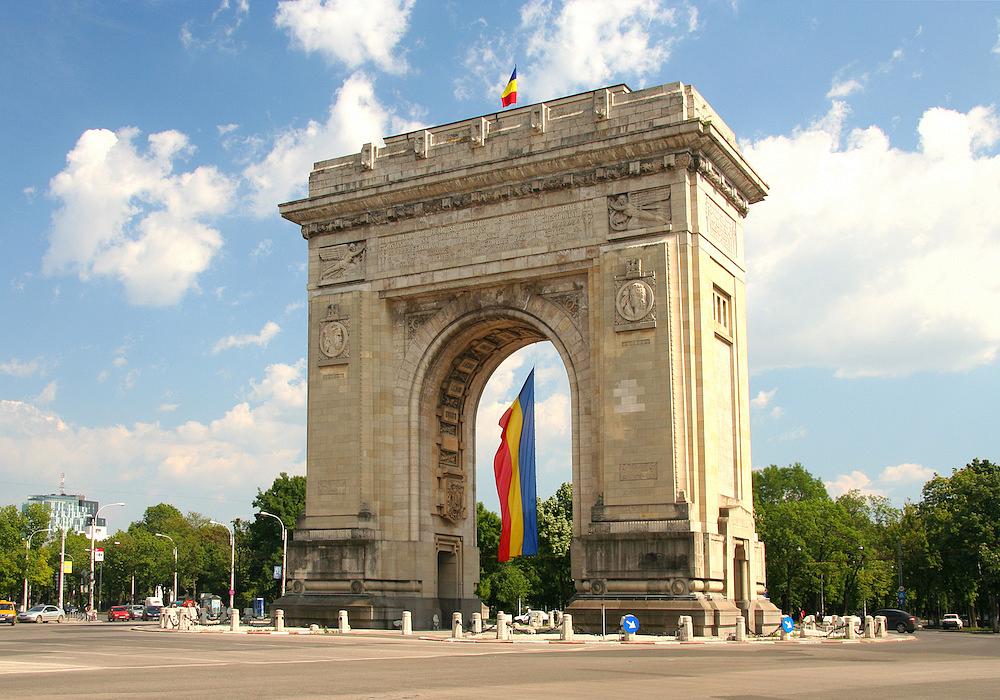Bucharest Centennial: The Arch of Triumph, a symbol of Romania’s Great Union



In the northern part of Bucharest, in the middle of one of the busiest intersections of the city, stands the Arch de Triumph (Arcul de Triumf). The monument reminds passers-by of the Romanian Army’s victory in the First World War and the Great Union of 1918 - one of the most important events in Romania’s history.
Built after the French model, the Arch of Triumph in “Little Paris,” as some used to call the Romanian capital city, is the “little brother” of the famous monument of the same name in Paris.
Every year on December 1, when Romanians celebrate their National Day, the Arch de Triumph is the main stage for the military parade organized in Bucharest. In 2018, the day of December 1 is all the more important as it marks the 100th anniversary of the Great Union, the historical event that led to the unification of all the historic Romanian provinces into a single state.
The Arch of Triumph is a historic landmark of Bucharest and a symbol of the city. Alongside the Mausoleum of Mărășești, the Heroes’ Cross on the Caraiman Peak and the Mausoleum and the Tomb of the Unknown Hero in Bucharest’s Carol Park, the Arch of Triumph commemorates Romania's participation in the World War I on the side of the Allied powers.
The story of the Triumphal Arch in Bucharest begins in 1922, four years after the Great Union, when the authorities of that time decided to organize a great parade to celebrate the event. For it, they built a temporary Arch of Triumph, made of wood, which was meant to replace the similar construction built in 1918 that had not withstood the bad weather. Later that same year, in preparation for the coronation of King Ferdinand I, the authorities decided to build a new, more resistant Arch of Triumph. The new monument was built in the area of the Kiseleff road, based on plans by architect Petre Antonescu. Unfortunately, due to the very tight deadline, only the monument’s skeleton was cast from reinforced concrete while the bas-reliefs were made of plaster, which resulted in the serious degradation of the construction in just a few years.
Ten years later, in 1932, pushed by the media of those days, the authorities decided to replace the exterior plaster bas-reliefs with new ones made of stone or marble. Construction work took much longer than for the previous stage, while the money came from the state budget as well as from public subscriptions where war veteran associations also pitched in. The inauguration took place on December 1, 1936, and the event marked one of the rare moments when Queen Mary appeared in public with her son, King Carol II.
The story continued, however, with dark times for the monument. The anti-monarchic, communist regime removed the images of Queen Mary and King Ferdinand I of Romania from the Arch of Triumph and replaced them with flowers. After the Romanian Revolution of 1989, which marked the end of communism in the country, the authorities placed on the monument two bronze medallions depicting the king and queen.
The Arch of Triumph entered extensive revamping in early 2014 and re-opened in late November 2016. During this period, the December 1 - National Day parades, which are usually organized here, were held in another part of the city. The military parades have re-started their ceremonial crossing under the Arch of Triumph on December 1, 2016. The monument will also witness the National Day annual parade this year when the country marks 100 years since the Great Union.
The Arch of Triumph in Bucharest is 27 meters tall, the interior stairs leading to the monument's terrace, where visitors can enjoy a unique view. The monument can usually be visited around December 1 as part of the National Day festivities.
By comparison, the famous Arch of Triumph in Paris, which is located at the western end of the equally famous Champs-Elysees, is 50 meters high. It was inaugurated in 1836 by French king Louis-Philippe, who dedicated it to the armies of the Revolution and the Empire. The tomb of the Unknown Soldier of World War I can be found at the base of the monument.
How to get to the Arch of Triumph in Bucharest:
The Arch of Triumph is located in Northern Bucharest, at the intersection of the Kiseleff road with Mareșal Constantin Prezan, Mareșal Alexandru Averescu and Alexandru Constantinescu Boulevards. Buses 131, 330, 331, 335, 205, 282 and 783 stop nearby, and the nearest subway station is Aviatorilor Square (Piața Aviatorilor). Those who are in the area can also visit the Village Museum, the Antipa Museum and the King Mihai I (Herăstrău) Park, which is in the immediate vicinity and one of the largest parks in the capital.
editor@romania-insider.com
Sources: Digi24.ro, Radioromaniacultural.ro, Wikipedia
(photo source: Adobe Stock)
